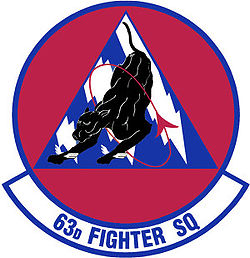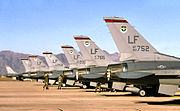| 63d Fighter Squadron | |
|---|---|
 63d Fighter Squadron Patch | |
| Active |
15 January 1941 – 18 October 1945 1 May 1946 – 8 January 1958 30 June 1975 – 1 June 2009 |
| Country | United States |
| Branch | United States Air Force |
| Type | Fighter Training |
| Part of |
Air Education and Training Command 19th Air Force 56th Fighter Wing 56th Operations Group |
| Garrison/HQ | Luke Air Force Base |
| Nickname(s) | Panthers |
| Engagements |
Battle of Normandy Battle of the Bulge |
| Decorations |
|
| Commanders | |
| Notable commanders | Lieutenant Colonel (later Colonel) John S. Loisel |

63d Fighter Squadron - F-16s on ramp

63d FS F-16D Block 42H Fighting Falcon 90-0783

63d TFTS F-4D-28-MC Phantom 65-0756, 1979

63d Fighter-Interceptor Squadron North American F-86A-5-NA Sabre 49-1223 56th Fighter-Interceptor Group, Selfridge AFB, Michigan, 1950

63d FIS (Air Defense Command)
The 63d Fighter Squadron (63 FS) is an inactive United States Air Force unit, last assigned to the 56th Operations Group, at Luke Air Force Base, Arizona. It operated the F-16 Fighting Falcon aircraft, conducting advanced fighter training until its inactivation on 22 May 2009.
History[]
World War II[]
- see 56th Operations Group for an expansive history of the squadron's World War II history
The 63d Fighter Squadron was constituted as the 62d Pursuit Squadron as part of the 56th Pursuit Group at Savannah, Georgia, on 15 January 1941. The squadron immediately began training for its wartime missions under III Fighter Command, rapidly transitioning through the P-35, P-36, P-39, and P-40 aircraft. On 7 December 1941, the 62d stepped up to defend the Northeastern United States from anticipated enemy air attack while it converted to the P-47 aircraft and prepared to deploy overseas, operating under the I Fighter Command, New York Fighter Wing in the early months of 1942.
It was re-designated 62d Fighter Squadron on 15 May 1942, and deployed to RAF Kings Cliffe (AAF-367), England on 9 January 1943. It was declared operationally ready two months later and flew its first combat missions 13 April. The squadron was given fuselage code "LM" and operated from several RAF stations during the war, flying the P-47C Thunderbolt as an VIII Fighter Command bomber-escort unit initially for B-17 Flying Fortresses and beginning in 1944 for B-24 Liberators attacking enemy targets in Occupied Europe. Flying escort for fighter sweeps ahead of U.S. bomber fleets, the pilots destroyed 167.5 enemy aircraft in the air and 110 on the ground. After the end of the war in Europe, the squadron demobilized in England, and was inactivated as an administrative unit on 18 October 1945.[1]
Cold War[]
The squadron was reactivated on 1 May 1946 as a Strategic Air Command escort fighter group, being assigned to Fifteenth Air Force at Selfridge Army Air Base, Michigan. Initially equipped with P-47D Thunderbolts, being replaced with long-range P-51H Mustangs, originally developed for Twentieth Air Force bomber escort missions in the Pacific Theater. The mission of the squadron was to provide fighter escort of SAC's B-29 Superfortress bombers on intercontinental strategic bombardment missions, deploying to Alaska and Europe in this role. In 1947, the squadron was upgraded to Lockheed P-80C Shooting Stars, as SAC introduced the B-50 in the late 1940s. The squadron trained to maintain proficiency as a mobile strike force, including bomber escort mission until transferred from Strategic Air Command to Continental Air Command on 1 Dec 1948.
The squadron began performing air defense missions with its relocation to Wurtsmith Air Force Base, Michigan and re-equipped with the F-86A Sabre. The squadron was re-designated as the 63d Fighter-Interceptor Squadron on 20 Jan 1950. It was assigned to Air Defense Command 4706th Defense Wing in February 1952. In 1954, the squadron was re-equipped with the purpose-built F-89H/J Scorpion interceptor. In 1957 began re-equipping with the North American F-86L Sabre. Moved to O'Hare Air Reserve Station, near Chicago, the squadron maintained the air defense alert at O'Hare until being inactivated in January 1958.[1]
The squadron was reactivated 30 June 1975, as the 63d Tactical Fighter Squadron at MacDill Air Force Base, Florida. Its mission was to train pilots and weapons systems officers for the F-4E Phantom II. It changed equipment to the F-4D in 1978, sending the "E" models to operational squadrons. F-16A Fighting Falcons started to arrive for the 63d in 1980 and was active with the F-16A/B by 1981. Squadron aircraft carried the "MC" tail code, with a red tail stripe outlined in white. On 1 October 1981, the squadron was re-designated the 63d Tactical Fighter Training Squadron even though it had always trained crew when it flew the Phantom II. Starting in 1988, the 63d converted to the F-16C/D block 30.
Modern era[]
On 1 November 1991, the host 56th Tactical Training Wing at MacDill implemented the Objective organization plan, and the subsequent re-designation of units led to the 63d becoming simply the 63d Fighter Squadron, and being assigned to the new 56th Operations Group. The end of the Cold War led to the BRAC commissions, and the downsizing of the Air Force to a smaller organization. As a result, it was decided first to close MacDill AFB, although under political pressure later it was realigned to a new mission. Like its two sister squadrons, the 61st and 62d FS, the 63d Fighter Squadron was reassigned to Luke AFB, Arizona, but instead of getting block 25s the squadron took over block 42 F-16Cs. The 63d was activated at Luke AFB on 25 February 1993. The move was one of the starts to the process of making Luke AFB the main F-16 Replacement Training Unit. On 14 January 2008, the 63d Fighter Squadron started a course that caught a few aviation headlines. They began training pilots selected to fly the F-22 Raptor, pilots who have never flown a fighter before. Up to this point F-22 pilots were hand-picked from the existing fighter community. Once the training in the F-16 was completed, the student pilots were reassigned to the 43d Fighter Squadron at Tyndall AFB, Florida where they spent the next two years training with the F-22.
In February 2008, it was announced that the 63d FS was to be inactivated as a result of BRAC 2005 that Luke AFB give up twenty-five block 25 F-16s. Although the 63d FS flew the Block 42 it transferred its F-16s to the 61st FS, which did operate the block 25. The 61st, due to its seniority and historical heritage, would remain active. On 4 April 2009, the 63d graduated its last class of F-16 pilots at which time it continued the process to inactivate. Officially the squadron stood down on 22 May 2009 after 68 years of service.[1]
Lineage[]
- Constituted as 63d Pursuit Squadron (Interceptor) on 20 Nov 1940
- Activated on 15 Jan 1941
- Re-designated as: 63d Pursuit Squadron (Interceptor) (Twin Engine) on 31 Jan 1942
- Re-designated as: 63d Fighter Squadron (Twin Engine) on 15 May 1942
- Re-designated as: 63d Fighter Squadron on 1 Jun 1942
- Re-designated as: 63d Fighter Squadron, Single Engine, on 28 Feb 1944
- Inactivated on 18 Oct 1945
- Activated on 1 May 1946
- Re-designated as: 63d Fighter Squadron, Jet Propelled, on 24 Apr 1947
- Re-designated as: 63d Fighter Squadron, Jet, on 14 Jun 1948
- Re-designated as: 63d Fighter-Interceptor Squadron on 20 Jan 1950
- Inactivated on 8 Jan 1958
- Re-designated as 63d Tactical Fighter Squadron on 12 May 1975
- Activated on 30 Jun 1975
- Re-designated as: 63d Tactical Fighter Training Squadron on 1 Oct 1981
- Re-designated as: 63d Fighter Squadron on 1 Nov 1991.
- Inactivated on 22 May 2009
Assignments[]
- 56th Pursuit (later, 56th Fighter) Group, 15 Jan 1941 – 18 Oct 1945
- 56th Fighter (later, 56th Fighter-Interceptor) Group, 1 May 1946
- 4708th Defense Wing, 6 Feb 1952
- 4706th Defense Wing, 1 Jul 1952
- 527th Air Defense Group, 16 Feb 1953
- 56th Fighter Group, 18 Aug 1955 – 8 Jan 1958
- 56th Tactical Fighter (later, 56th Tactical Training; 56th Fighter) Wing, 30 Jun 1975
- 56th Operations Group, 1 Nov 1991
- 58th Operations Group, 25 Feb 1993
- 56th Operations Group, 1 Apr 1994 – 22 May 2009
Stations[]
|
|
Aircraft[]
|
|
Operations[]
References[]
This article incorporates public domain material from the Air Force Historical Research Agency website http://www.afhra.af.mil/.
- A Handbook of Aerospace Defense Organization 1946 - 1980, by Lloyd H. Cornett and Mildred W. Johnson, Office of History, Aerospace Defense Center, Peterson Air Force Base, Colorado
- Maurer, Maurer. Combat Squadrons of the Air Force: World War II. Maxwell Air Force Base, Alabama: Office of Air Force History, 1982.
- USAF Aerospace Defense Command publication, The Interceptor, January 1979 (Volume 21, Number 1).
- Martin, Patrick. Tail Code: The Complete History of USAF Tactical Aircraft Tail Code Markings. Schiffer Publishing, 1994. ISBN 0-88740-513-4.
- Rogers, Brian. United States Air Force Unit Designations Since 1978. Hinkley, England: Midland Publications, 2005. ISBN 1-85780-197-0.
- USAF 63d Fighter Squadron History
- 56th Operations Group Fact Sheet
| ||||||||||||||||
The original article can be found at 63d Fighter Squadron and the edit history here.
